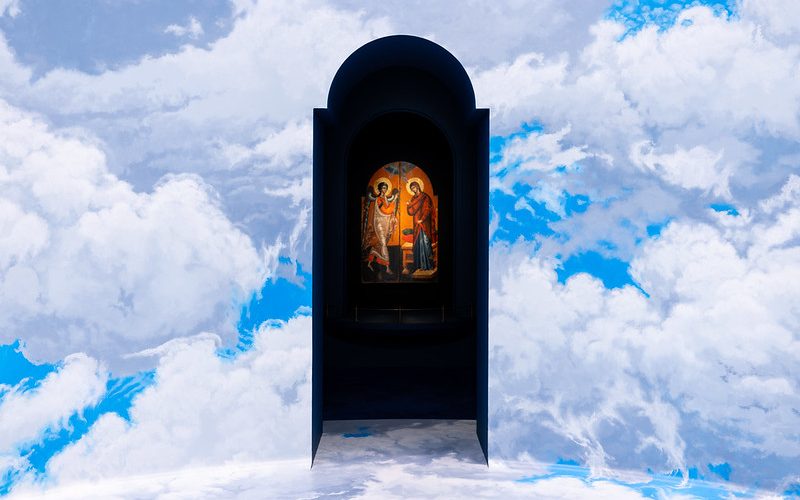As both a Mona “virgin” and mainlander who had only visited Tasmania once before, this reviewer (writing during a return flight to Melbourne) has to commend the institution on creating deep, lasting and impactful memories. They are the type that perhaps many have been starved of for far too long – particularly in more recent times when cultural institutions have seemingly forgone gusto for economics in the wake of the pandemic.
It has been exactly four years since art has made this writer really feel something – the last time being when Hofesh Shechter presented Grand Finale for Melbourne International Arts Festival in 2019.
So often as a tourist, attractions talk a big game to entice you to visit, but rarely live up to the hype. Yet, Mona took this writer’s breath away more than once in the space of an afternoon – it’s been a long time since art touched them like that.
Being sucked as it were into the bowels of this incredible space – by way of the single glass lift in its inconspicuous lobby – is both a magnificent and darkly gothic start to the journey. There is indeed a fierceness or perhaps independence to the curatorial approach here that leaves those adopted by other major cultural institutions for dead.
Straight after slipping out of the lift at ground zero viewers find an admirable queer take on the Burke and Wills tale – the work of visual artist Juan Davila depicting one of these colonisers being rimmed by a kangaroo. Alongside hangs a sobering photographic work of a female nude. These two pieces, the first to be seen by this reviewer, seem to speak to each other and tempt the intrepid visitor deeper and deeper into the depths of Mona.
As was reported by ArtsHub in September, the institution launched a new major triple bill and none of these three experiences – because they are more than mere exhibitions – disappoint.
This writer spent a good hour just soaking up the gothic splendour of Heavenly Beings: Icons of the Christian Orthodox World. As Mona’s first exhibition of entirely “old art” it’s a standout. Presented are 140 artefacts in a series of darkened catacombs that spread from a central, brightly lit space. Bestowed with cloud murals that are akin to the ceilings in the Sistine Chapel capped off by a mirrored ceiling, this exhibition traces the spread of orthodox religion through iconography, maps and, of course, artefacts.
It may be this writer’s affinity with darkness but Heavenly Beings is as close as they have ever got to a religious experience, either in or outside of a cultural or religious institution.
Jean-Luc Moulène and Teams is next up and is perhaps the most conventional presentation of the three. Here materials endemic to Tasmania have been reimagined. Taking ‘timber from primeval Tasmanian underwater forests, Triassic sandstone, wax and metal’, a series of tactile and almost sensual objects are presented in a single room. The concrete floors and stark white walls elevate these objects further. The visitor is asked to reimagine the ancient through a contemporary lens.
The third of this new triple bill is an entirely different experience. Jónsi Hrafntinna (Obsidian) by Jónsi (better known as the lead singer of Icelandic post-rock band Sigur Rós) fills the darkened space with deeply emotive sounds and aromas. The experience, which simulates the depths of a volcano, envelops visitors, transporting them to another space and time.
The last time this writer experienced a work that incorporated scent was during an edition of the Asia Pacific Triennial of Contemporary Art at Queensland Art Gallery perhaps a decade ago. Over the years, this writer has been involved in major works at such institutions as Queensland’s Gallery Of Modern Art (as a performer in Nick Cave’s HEARD•BNE 2016 for the Gallery’s anniversary GOMA10) and had indeed, up until this very point, looked toward Sydney’s Museum of Contemporary Art (MCA) as the shining beacon for engaging with new and contemporary visual practices. Even after 17 years in Melbourne, this adage still rang true. Not anymore.
When visiting Mona, it is not simply about being a viewer of the work, engaging from a distance; instead the space is steeped in a non-traditional and heightened ambience that is rarely if ever seen. For example, the way in which Picasso’s work is displayed within the exclusive Ladies Lounge at Mona is far removed from how we see works from the same artist at the National Gallery of Victoria.
It also interesting to note that, unlike other institutions, Mona does not provide visitors with the typical “plaque on the wall” type of explanations. Instead, visitors are encouraged to download the institution’s app (the O) and use this as a self-navigation tool. This writer chose to forgo the use of the app soon after making the descent into Mona. By making this choice, the experience was one that needed no explanations and was fully immersive.
Read: Dance review: Angela Goh Axe Arch Echo, AGNSW
It’s hard not to gush when art is this good and with Mona’s penchant for exploiting the worst of their reviews, this take will unlikely garner much attention from the private museum… But who cares because, after a single afternoon, this writer once again believes in the power of art to create a truly transcendent experience.
Heavenly Beings: Icons of the Christian Orthodox World, Jean-Luc Moulène and Teams and Hrafntinna (Obsidian) run until 1 April 2024 at Mona; ticketed with museum entry.
This review is published under the Amplify Collective, an initiative supported by The Walkley Foundation and made possible through funding from the Meta Australian News Fund.





